We thoroughly enjoyed our travels in Europe for the summer of 2007. Following is a brief summary of our trip with links to our stories of where we went, what we saw and some of what we learned. We hope you enjoy them.![]()
![]()
Early in 2007, while we were still on the road, traveling with our trailer home in tow, we began research and planning for our move to Europe for the Spring and Summer. Neither of us has ever lived outside the US and we believe that viewing the world from a new and different perspective is essential if we are to be better global citizens.
The preparation to be away from Albuquerque and outside the US for an extended time turned out to be much more extensive than we had anticipated and took careful planning. An essential part of this plan was the storage of our trailer home in a secure, roofed facility in Phoenix and delivery of our truck to Blairís daughter.
By April 10, 2007, we had completed all the tasks in the workplan and were ready to leave. We had arranged our air transportation from Phoenix using special discount airline tickets with US Airways that are available to us due to Blairís long service at Eastern Airlines. The caveat is that we must fly stand by, which means that is we fly only if empty seats are available on a flight.
So, very early in the morning, Blair's daughter drove us to the Phoenix airport to begin our trip. We spent all day plus half of the next trying to leave as all the flights to the East Coast were full. Finally on the afternoon of April 11th, we made a connection through Las Vegas to Baltimore, and then took Amtrak up to Philadelphia to catch our flight to Europe. As the Madrid flight we preferred was full, we caught a flight to Rome. Once in Rome we found a flight to Barcelona on one of the discount airlines now operating in Europe.
Following our plan, we lived in Spain until the end of June. See the links for Spain below for those stories.
We moved to Brussels for the rest of the summer and have many stories of our experiences with urban living and the impact of the European Union on this historic city. See the links below for Belgium and Brussels below.
At the end of August, it was time to move on. We spent the next three weeks traveling, visiting Munich in Germany and then Harlow, London and Manchester in England. You can read these stories using the links below.
We returned to the US late in September.
This episode in our lives is now complete. Click on the links below to read our stories.
![]()
Spain
Barcelona
Madrid
- Setting in Madrid
- Setting in Madrid 2
- Urban Ecology
- Conumbrum of Cars
- Madrid's Wonderful Museums
- Time to Move On - Our daytrips from Madrid and on to Andalucia - see the links below
Andalucia - Our Travels in Southern Spain
- Cordoba
- Sevilla
- Donana National Park and Sanlucar de Barrameda
- Algeciras and Gibralter
- Algeciras to Granada by Train
- Granada, with Our Picture Gallery of the Alhambra
Making Friends and Doing Business in Spain - Our Experiences
Belgium and Northern Europe
Brussels
- Brussels - Our First Impressions
- Brussels - Enjoying Urban Living
- Brussels is a Comfortable, Livable City
Day Trips from Brussels
- Antwerp - The Second City of Belgium and Capital of Flanders
- Bruges - Charming Medieval City
- Ostend - Beach Resort City on the North Sea
The European Union (EU) and Its Place in Brussels, Its Capital
England
Click here to return to the Our Search page, or,
Click here to return to our PioneerWest home page.
Barcelona - Update After Two Weeks
In a phenomenal two weeks of exploring Barcelona, we have adjusted to the new time zone, GMT +1, and settled in at the Pension Palacio, where we had a double bed room, access to a kitchen for fixing some of our meals, plus WiFi Internet service.
we walked through the many neighborhoods of the old City, along the busy Las Ramblas and through the serene tree shaded hills of Parc Montjuic. We visited the eclectic, innovative and awe inspiring buildings of Antoni Gaudi, roamed the halls of the Museu National d'Art Catalunya savoring the collection of paintings and sculpture housed there, and spent 2 days learning Catalan history in the Museu d'Historia de Catalunya. We also found that Barcelona was filled with visitors, with mobs of people at the main sights and many huge tour buses dominating the main roads.
One of our first stops was the Boqueria Market, Barcelona's daily food market in a covered hall just off Las Ramblas. You can buy all of your food needs here and there's even an 'Organic' section and a place to get a fresh fruit snack. It's strawberry season so we will return often.
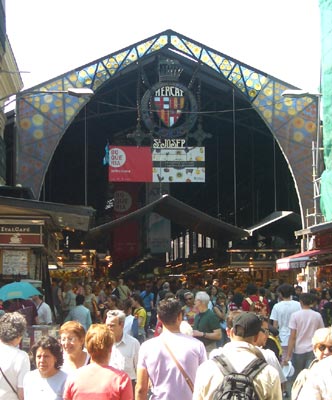
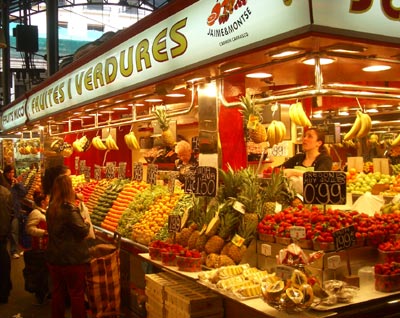
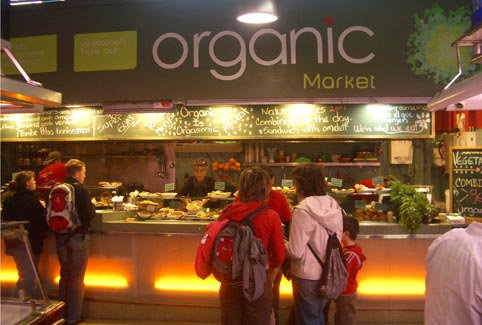

Antoni Gaudi lived in Barcelona and planned some wonderful but eclectic looking buildings. We have visited two of the more well known.
- The Casa Pedrera is an apartment building, but certainly far from normal (2 pictures below).
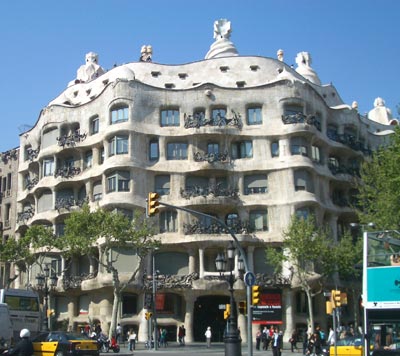
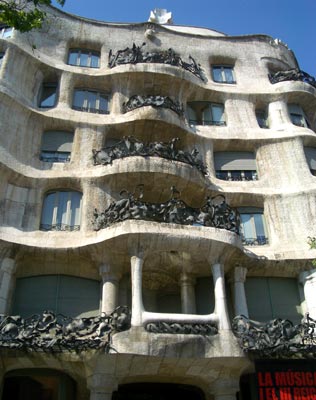
- The Sagrada Familia Cathedral.
This place takes your breath away - it is so large and so detailed that you just stand there in amazement. We will certainly return many times to catch the change of light, and also to visit the inside. (The top 2 pictures are the west face and bottom 2 the east face).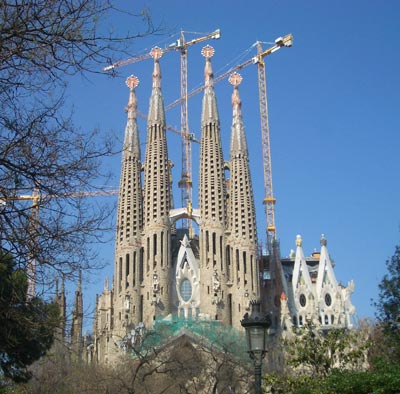
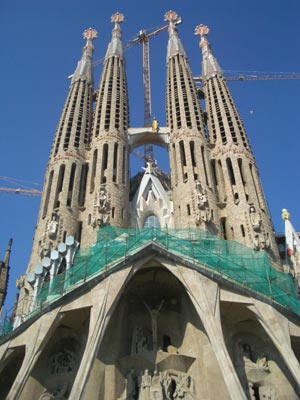
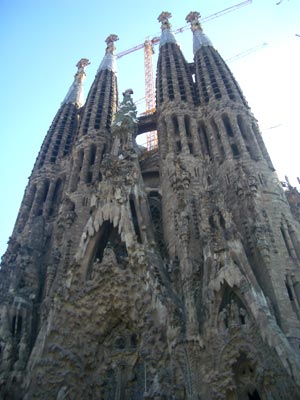
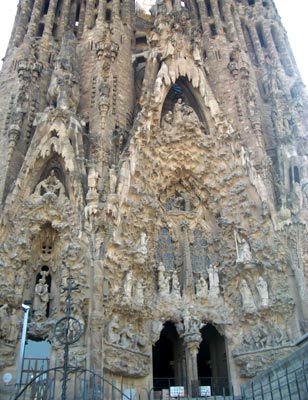
Unfortunately there will be construction cranes in our views for many years. We have seen plans for the completed structure which will take at least 13 more years to complete. (pictures of models below).
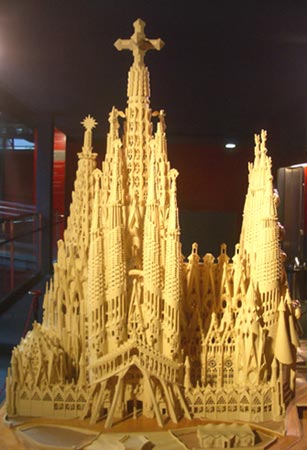
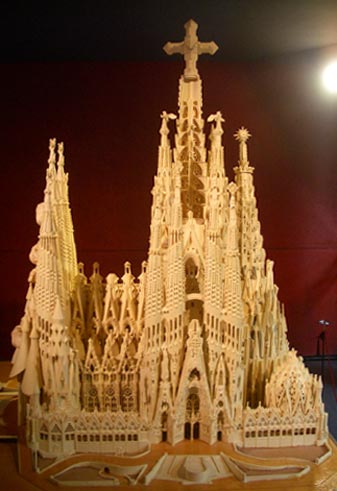
Joan (John) Miro also worked here. We visited Parc Joan Miro (picture below).
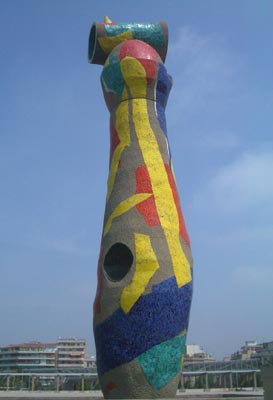
Living at Pension Palacio
During our explorations of Barcelona, we lived at Pension Palacio, possibly the perfect place to stay! The Pension is located on the edge of Barri Gotic, near the harbor. In our walks around the area, we discovered charming narrow streets, shops of every description, any number of cafes, tavernas and restaurants. All of Barcelona's attractions are easily assessable by walking, busing or metro riding.
The Pension is on the second floor (third floor by US count) of a large building also inhabited by shops and restaurants on the ground floor and a mix of residences and businesses on the other floors. It includes a small sitting area, a complex of guest rooms of various sizes, shared bathrooms, a computer room, and a kitchen with TV, where everyone gathered when soccer matches were on (left below). Our comfy room was small but quite adequate, with a double bed, table and chair and a sink (right below). We cooked and ate some meals in the kitchen and kept food in the refrigerator. Since we have our laptop computers with us, we were thrilled to learn that they had Wifi available.
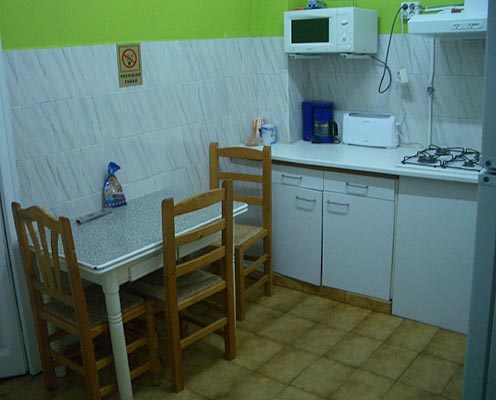

We found this arrangement to be quite livable and during the two weeks, we became friends with Mario and Nuria, the owner/managers. They work hard to make everyone welcome and comfortable! If you're planning to visit Barcelona, consider staying with them!
Barcelona's Urban Ecology
We give Barcelona a high rating as a People Friendly City! During our first walks, we realized that this is a city where walking and bicycling are respected modes of transport. Of course, there are plenty of cars, trucks and buses on the streets, too. Our first walk was along the waterfront to the statue of Columbus (left below) and on up shady tree lined Las Ramblas (right below), with its tourist shops and mimes, to grand Plaza Catalunya, then back along the Avinguda Portal de L'Angel, the wide shopping street lined with stores, large and small - all places where walking and cycling take precedence over vehicle travel. In fact 'pedestrian jams' can occur during the times when everyone is out and about.
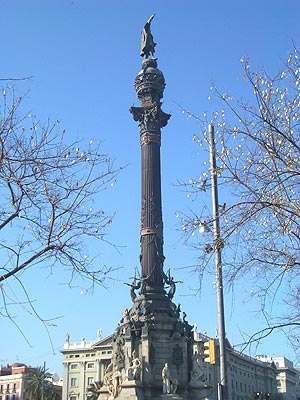
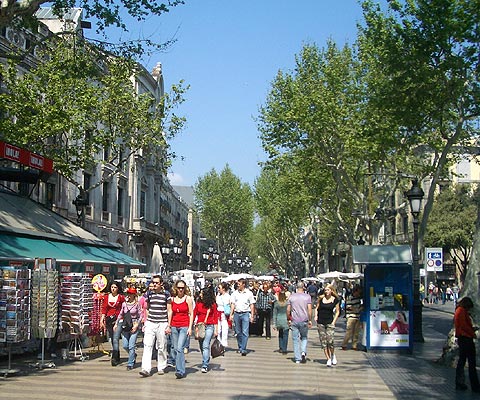
In the oldest parts of the city, the streets and lanes are really too narrow for cars except an occasional delivery vehicle (left below). These narrow lanes give the city an organic charm that would be difficult to duplicate today. At the same time, as we wandered and looked, we wondered if we'd really enjoy living here full time. The atmosphere is almost surreal to our 21st century eyes and heads, perhaps too antique for us as children of American suburbia. Perhaps as we plan and design our 21st century cities to meet the challenges of the future, we should respect and admire the charms of 16th century cities but not necessarily try to recreate them.
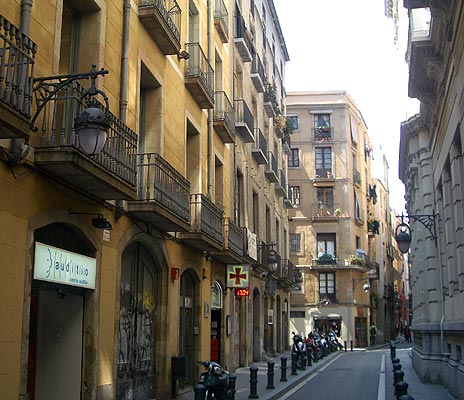
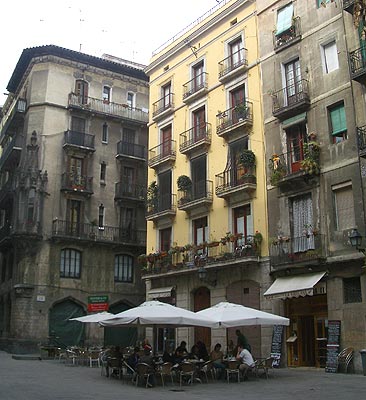
In fact, Barcelona has done remarkably well at gracefully integrating modern transport systems into the existing urban fabric. Car parks and their extensive Metro (subway) are underground, providing additions to the surface systems to serve the mobility needs of the city's 4+ million people. Buses run all over with headways short enough to make actual schedules unnecessary; riders just go to the bus stop, confident that a bus will come soon. More recently, a tram line was added to augment the capacity of the transport system. As we traveled around, we speculated on why anyone would need a car at all!
What makes this transport system work is the overall development intensity of the place. Most buildings in the older areas are 4 to 6 stories high and in the more modern areas, higher rise buildings are the norm. This intensity creates the population density that makes efficient non-car transport feasible. At the same time, the mixing of land uses enables people to shop for most daily needs by walking. A possibly related reality is that, we observed fewer overweight people than in the US!
Madrid - Our Experiences and Impressions
While still in Barcelona, we used the internet and our new Spanish cell phone to arrange the rental of a studio apartment in Madrid. We then traveled by train through the rolling green and brown mosaic of the Spanish countryside to arrive here.
We quickly learned that upcoming 1 de Mayo is a national holiday and 2 de Mayo is a holiday for Madrillenos, so many shops and museums were closed. Still, we were able to move into our new place (pictures below) and begin "nest making", and exploring our own very urban neighborhood.
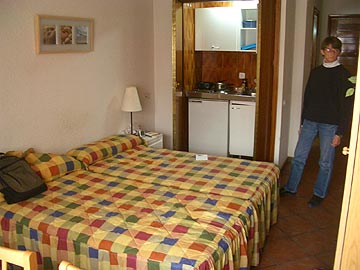
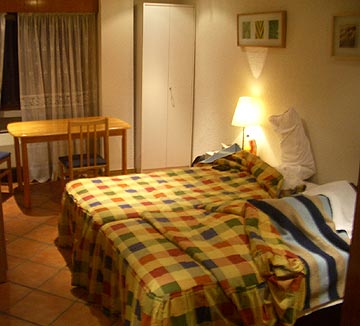
It's really true that Madrillenos keep hours that could not be more different than the ones we normally keep. Business hours are 9:00 to 14:00 and 17:00 to 20:00 (24 hour clock). Lunch is after 14:00, dinner is after 21:00 and the streets are still filled with people way past 24:00!
Monday evening, we met our new friend, Narciso, (whom we met by E-mail through our Indian friend, Saurabh) for a real Madrid evening. We began with churros (light fried dough sticks) and cups of chocolate, thick and dark. While we ate we talked about travel, the role of the European Union, World politics and life in Spain. Next we walked past the regal Palacio Real (picture below) and Casa de Villa and on into a convoluted maze of narrow calles in the old city to search for a Taverna for Tapas.
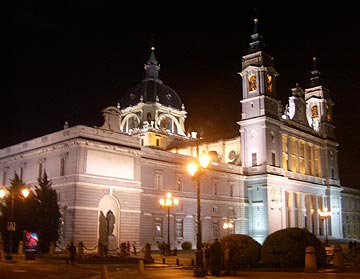
By now it was 22:00 and every place was packed with diners. Narciso assured us that these folks are locals, not turistas and that this is a typical night in Madrid. We found a good place and savored tapas of grilled veggies, strong Spanish cheese similar to roquefort, and salad with olives, bread and short crunchy bread sticks, all washed down with cerveza.
The next morning, we awoke to the realization that we'd have a hard time becoming true Madrilenos! Most probably, one must be born here to live on a true Madrid schedule. Still we have discovered that the cafes, cafeterias, tabernas and cervecerias serve food at almost any hour after noon (pictures of two we like below). And now, we have our own cocina so we can fix meals on our schedule. Plus, there are many shops that sell prepared foods of all sorts to take home.
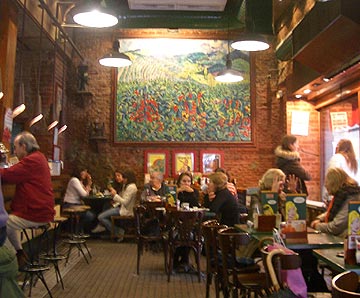
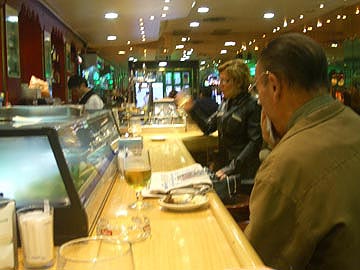
Spanish food is different from any other cuisine we have tasted, quite good but heavily meat intensive. Finding veggie options takes a bit of doing, but it can be done! Tortillas, a sort of omelet, either plain or filled with potatoes, and salads of mixed greens are pervasive. Sandwiches with cheese and veggies can often be found, too. Then there are the Turkish Donner Cafes where falafel sandwiches and salads can be had. So, between all these choices, cafes with wonderful pastries and some home cooking, we should eat pretty well.
As newly arrived residents, we spent the first week or so settling into our home and neighborhood. We've done this many times before in the US so we know the process! First comes the search for sources of food and other daily necessities, Internet access, laundry service, stamps, copies, fax, etc. In a few days of walking around the area, we discovered a friendly coffee shop with free Wifi access and several shops that offer fax service and copies. Our apartment has a laundry service, slow and costly, so we wash by hand in our bathroom! A tiny kiosk at the corner, an estanco, sells stamps and transit tickets (below left). For food shopping, within easy walking distance, we have Carrefour Express, a supermercado, and another Mercado for frutas and verduras, rather like a smaller version of the Boqueria in Barcelona (below right).
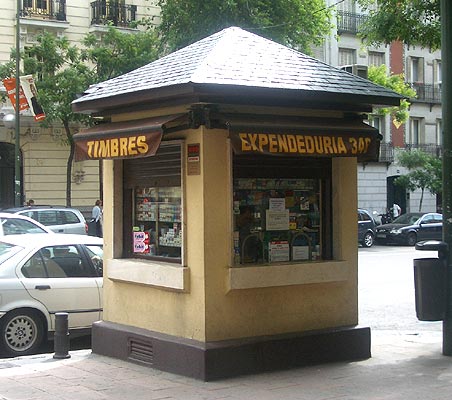
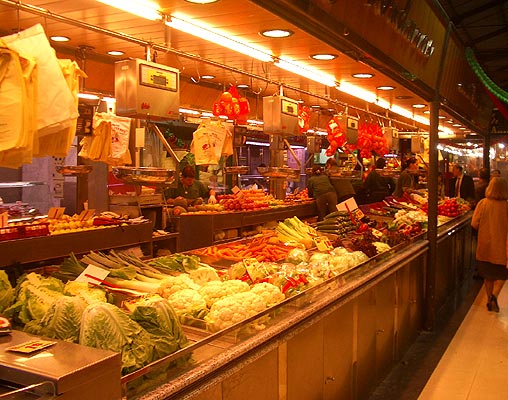
Then there are a number of Alimentarios, small shops that sell an array of daily food necessities and small shops selling frutas and verduras. So, food shopping is easy and convenient. We have quickly learned to buy only what we can carry home!
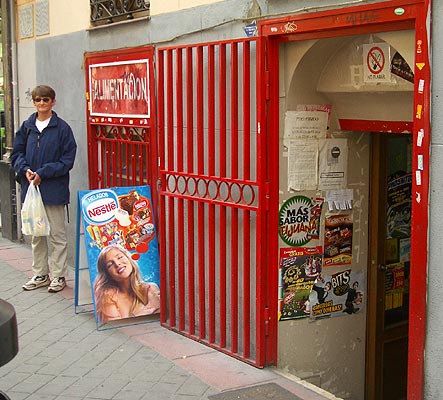
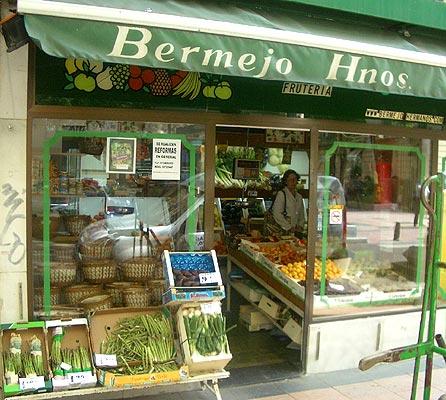
Our neighborhood (barrio), Salamanca, has turned out to be one of the more affluent ones in central Madrid. During our walks, we have discovered shops selling expensive clothing, furniture and artwork as well as everything else one might want. The sidewalks are always crowded at all hours. We see well dressed older couples holding hands as they stroll, young men and women in fashionable business attire hurrying along as they talk on movil phones, older men in expensive suits chatting as they walk.
In the mornings, people hurry to work dodging men pushing loaded hand trucks delivering goods to the shops. In the afternoons, around schools, there is a flurry of activity as parents or grandparents pick up their kids and walk home together. Older kids walk home in twos or gather in groups along the street to laugh and talk together.
Urban Ecology
What makes this place so vibrant and full of life? It has to do with the presence of people, of course, and also the physical form of the streets, sidewalks and buildings. We are attempting to document the elements that create this urbanity through images and words and will share our discoveries with you.
The buildings along the smaller streets are five to seven stories high with shops at the sidewalk level, offices on the next floor and apartments above. Many of the buildings have black iron railed balconies or terraces, sometimes a roof garden, and decorative embellishments on the walls and across the rooftop (left below). Newer buildings, interspersed with these, have the more austere design of "modernity", perhaps lacking the embellishments but adding interest and contrast along the street (right below). The overall impression as one walks along is stimulating and agreeable.
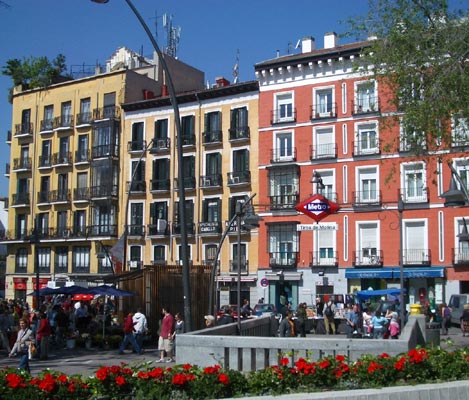
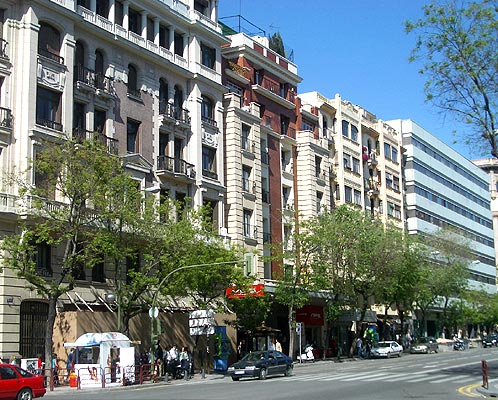
Unlike many of Madrid's older barrios, Salamanca's streets are built in a grid of small blocks. The street width is only sufficient for one travel lane because parking, parallel or diagonal, is allowed on both sides so every street is one way (left below). At intersections, cars must stop to allow pedestrians to cross (below right). This combination significantly slows the speed of vehicle traffic and makes walking more pleasant and safe.
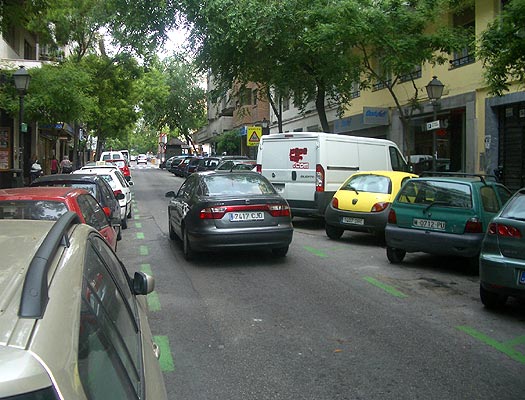
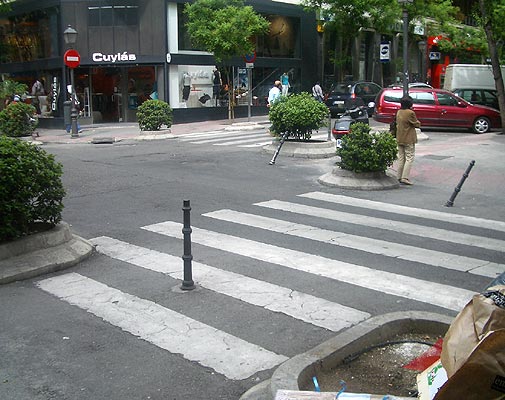
The larger arterial streets have multiple lanes of traffic. The sidewalks are fairly wide, but still quite crowded. The intersections have signals with long walk lights and wide crosswalks (below), so crossing is fairly easy and safe. Madrilenos love to walk past the stores sometimes stopping to enter, but more often just window shopping.
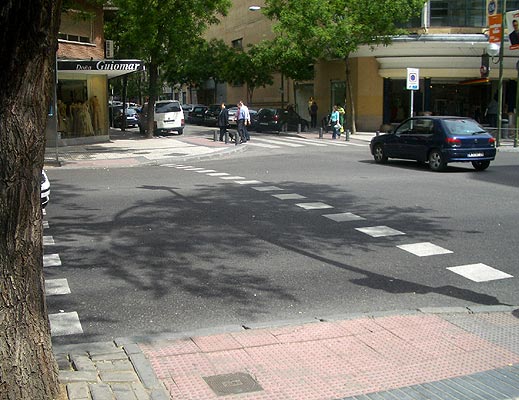
Our mobility is provided first, by our feet! This barrio is people scale and most destinations are a walk away. For longer trips, we have a choice of the Metro (subway) or buses that run with amazing frequency from early to late in all directions. We prefer the buses because they run on city streets enabling us to sightsee as we travel. We are taking trips to other barrios to observe how the other Madrilenos live and we use the buses or Metro to travel to events and places we wish to visit. We don't miss driving at all!
Less than a kilometer away is Buen Retiro Park, Madrid's "Central Park" where one can walk along paths under great shady trees, past formal and informal gardens and small ponds, to connect with the natural world. This park is large enough so that as you walk toward the center, the traffic noise fades away and bird twitters can be heard. Of course, plenty of people come here, too, especially on Sunday, so it's not a solitary experience (pictures below).
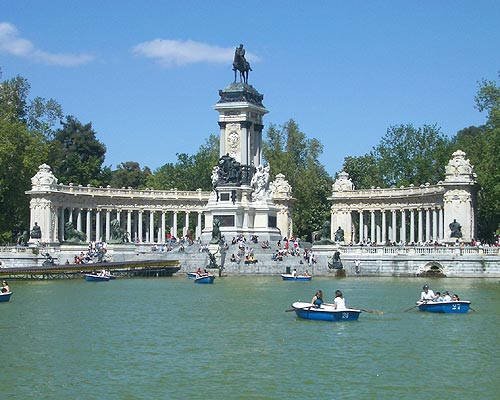
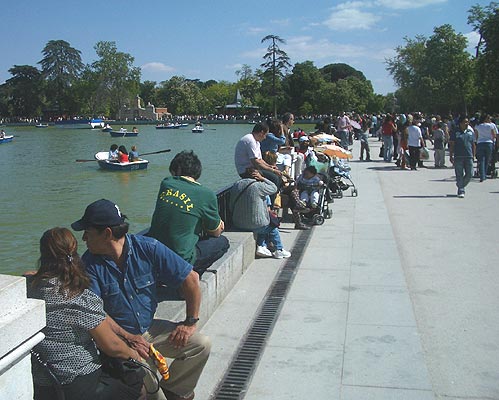
While solitude is a scarce commodity in a truly urban center, Madrid offers many other parks, some of grand size such as Casa de Campo and many smaller ones, often with playgrounds. Then there are the more formal jardins, like Campo de Moro (pictures below) and Jardenes de Sabatini, near the Palacio Real, so at least a small piece of the natural world is within reach.
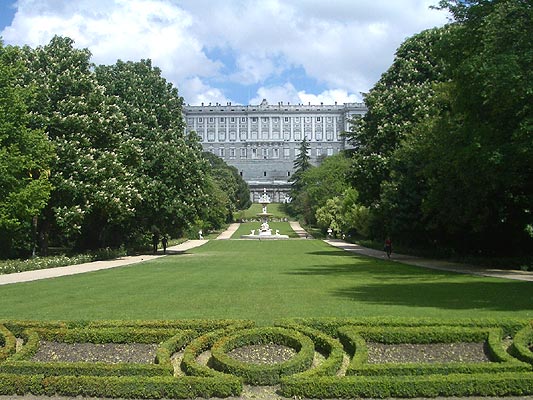
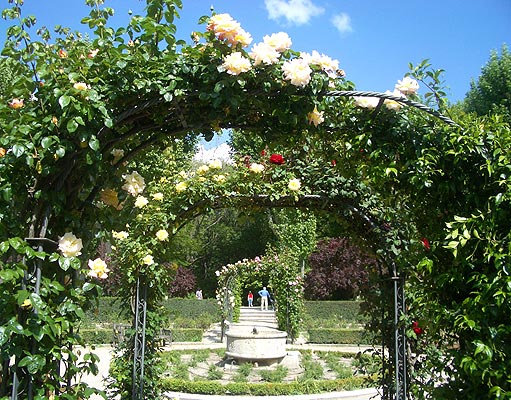
Overall, we give Madrid a fairly high rating as a People Friendly City. One area where the City would lose points is accommodation for cars. There is a massive investment in construction of motorways and parking. Most parking is underground, under buildings or in 'garages' under roadways and larger intersections (picture of an entrance, left below). Some roadways are underground or are in tunnels under major intersections (we call them 'fly-unders')(right below). We have yet to see an above ground parking structure!
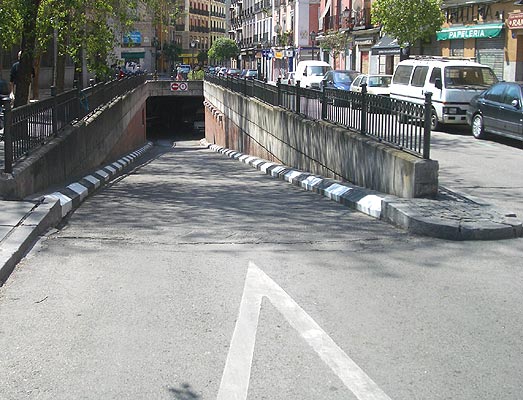
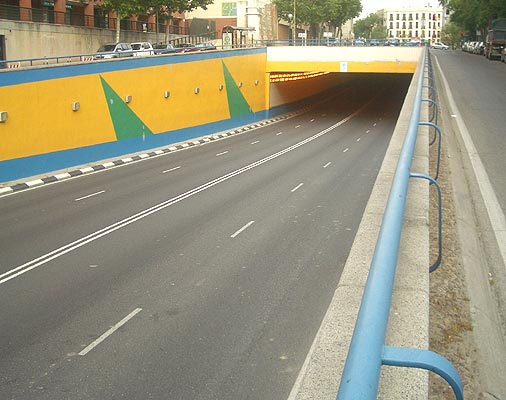
In a place where transit is so easy and accessible, it is a mystery to us why so many people drive. Single Occupancy Vehicles abound, often inching along in traffic congestion. We guess that if everyone stopped driving and traveled by transit, the system would be overloaded but with fewer cars clogging the streets and roads, there would be more room for the additional buses!
We guess that as oil prices climb, more people will leave their cars at home and ride transit, thereby allowing a larger share of the funds now used for roads and parking to be invested in enhancing the transit system. Unlike most cities in the US, Madrid has a functioning transit system already in place, ready for enhancement!
The Conundrum of Cars
What is it about cars and people? Here in Madrid, where the transit system works so well that driving is truly optional, people still drive. In the late afternoons, they sit stuck in traffic honking horns and talking on movil phones, probably explaining why they will be late getting home. Both the City of Madrid and the Communidad (region) of Madrid are investing Enormous Euros to add lanes and build fly-unders for the motorways that encircle the area in concentric circles to enable and encourage driving.
The cars are mostly small and probably get over 17 kilometers per liter (40 mpg) but gas costs 1 euro/liter ($5+/gallon) so driving is expensive. Add in parking at up to 20 euros/day ($27) and compare that total with a monthly "transit abono" for unlimited bus and Metro rides at about 40 euros ($54). Does this make sense?
We guess that part of the answer is that some of the people now have the money to have a car and they want to exercise their right to drive it, no matter the cost, perhaps feeling they have worked their way up to the point that they are 'above' traveling on public transit. Others may feel that they just don't want to travel with the crowds of people that ride public transportation. It's too bad that this type of thinking is becoming so prevalent in so many places in the world and especially in most American cities.
In comparison, our friend, Narciso, has a car but he bought his apartment because he can take transit to work instead of driving. He confessed that he walks and takes transit so much of the time that he has nearly forgotten how to drive!
We have taken short excursions to Segovia and Toledo, both very old cities that, like Santa Fe, were built centuries before the automobile was even a dream. Cars on the narrow streets of these cities are an anachronism and a peril to pedestrians. We found that our appreciation for the charm of these narrow cobblestone streets, winding steeply up and down the hills and lined with balconied apartments bright with flowers, was disrupted by the need to listen for car or cycle engines and flatten ourselves against a wall to avoid being hit!
Why are cars allowed in the central cores of these ancient cities? Why are people so determined to drive through these narrow lanes? These cities both make their living entertaining tourists so one might think it would make economic sense to just say "No!" To cars.
OK, end of rant!
go to Madrid's Wonderful Museums
Click here to go to our PioneerWest homepage.
![]()